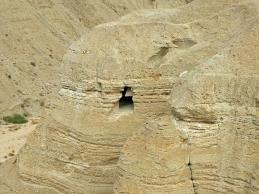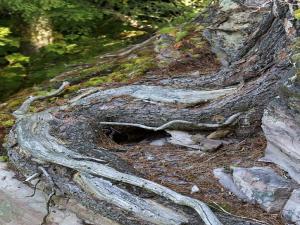 A recent discovery was made in Colorado at the Mesa Verde National Park. It seems that what has been considered for a long time to have been an Ancestral Puebloan water reservoir – that has been standing for a thousand years – may not have actually been erected to store water.
A recent discovery was made in Colorado at the Mesa Verde National Park. It seems that what has been considered for a long time to have been an Ancestral Puebloan water reservoir – that has been standing for a thousand years – may not have actually been erected to store water.
Instead, it seems that the latest study concludes that given that it is on a ridge, US Geological Survey scientist Larry Benson pointed out that “it’s hard to believe that Native Americans who understood the landscape and were in need of water would have decided to build a reservoir on that ridge.” Thus those in the study believe that Mummy Lake – what was thought to have been a water reservoir – was actually instead “an unroofed ceremonial structure” a bit like ancient kivas and plazas common in the Southwest. It also looks a bit like a Arizonian amphitheater that was also originally considered a water reservoir.
Around 20 years ago an evolving ritual landscape was discovered by researchers studying the Manuelito Canyon Community of New Mexico. Throughout history, the Manuelitos changed the ritual focus of their community, developing ceremonial roads to connect their retired great houses and great kivas to the new complexes. Benson’s group believes the same thing occurred at Mesa Verde, concluding that it is time for “new signage” on the structure…We could probably call it ‘Mummy Lake’ again.”
US Anthropology and the Lego Revolution
 Top executives at Lego have been using German and US anthropology in their road to continued success. This was done by placing anthropologist researchers into families, seeing how they interact, and, with a special focus on their play.
Top executives at Lego have been using German and US anthropology in their road to continued success. This was done by placing anthropologist researchers into families, seeing how they interact, and, with a special focus on their play.
In an attempt to get Lego back on track, executives sought to demystify the notion that customers “no longer had to time to play” through research in the field of US anthropology. They wanted to figure out if 21st century “plug and play” games were rendering old-school Lego play unpopular.
Interestingly what happened in this US anthropology research was that it was found that children these days do still have a lot of free time and in this time, they enjoy tackling challenging problems. Further, when they weren’t being supervised, their behavior and actions were different to when they were being supervised.
Interestingly what has been found – by researchers Christian Madsbjerg and Mikkel Rasmussen, (ReD Associates’ founding partners) – is that the way to really understand what’s going on is by anthropology. That, as opposed to questionnaires and spreadsheets. Culturally going in and experiencing what is happening is going to give us a much more accurate analysis of what children like to do. At least, that is what Lego has found. And they are pretty successful.
New Americans US Society Integration
 A non-profit organization to help support immigrant groups throughout America was recently launched by Henry Cisneros. The former Mayor and Housing Secretary and current CityView Executive Chairman, set up the Cisneros Center to “identify best practices among these groups and promote an immigrant “road map” to accelerate their integration into U.S. society.” The idea was also that it should be used as a kickback to the escalation in US immigrant populations. Retired US diplomat Cecilia Elizondo Herrera will be the center’s CEO and first president in San Antonio with Nicolas Perilla as executive director in Washington DC. José Estrada will be the center’s regional manager in Arkansas.
A non-profit organization to help support immigrant groups throughout America was recently launched by Henry Cisneros. The former Mayor and Housing Secretary and current CityView Executive Chairman, set up the Cisneros Center to “identify best practices among these groups and promote an immigrant “road map” to accelerate their integration into U.S. society.” The idea was also that it should be used as a kickback to the escalation in US immigrant populations. Retired US diplomat Cecilia Elizondo Herrera will be the center’s CEO and first president in San Antonio with Nicolas Perilla as executive director in Washington DC. José Estrada will be the center’s regional manager in Arkansas.
The Cisneros Center will seek to create awareness of the true “urgency” encountered by immigrants on education and other such issues common in their new lives. It will be Cisneros’ “single, focused effort” in civic life. He believes that strong immigrant communities are what will “save our country.”
The main role of the Center will be to assemble nonprofit groups, academics, faith-based organizations and those with a foot in the door of immigrant communities to brainstorm the best ideas to deal with isolation. As Perilla pointed out, there are “new gateways that have experienced dramatic demographic shifts in the last 20 years and are still in the process of building the infrastructure to serve them,” which have “so much potential,” but are lacking the necessary tools.
US Anthropologist Becomes Voice of the Dead
 Two organizations – the Joint POW/MIA Accounting Command and the US Army Central Identification Laboratory were the driving force behind a team of scientific anthropologists who are in the process of investigating American military remains that were unearthed in places around the world.
Two organizations – the Joint POW/MIA Accounting Command and the US Army Central Identification Laboratory were the driving force behind a team of scientific anthropologists who are in the process of investigating American military remains that were unearthed in places around the world.
As part of this project, head of the team, forensic anthropologist Marcella Sorg, has been trying to figure out the root of various “trophy skulls” that have appeared in Maine following the deaths of veterans from the second World War. Also in this category are bones of enemy fighters that were taken as military service souvenirs and discovered by family members.
In her position, Sorg is often asked to investigate unknown human skeletal remains. In this way, she can figure out the identity of the individual and if their death was caused by a murder. In her US anthropology work over the years, Sorg has found a “steady increase” in the amount of drug-related deaths over the last decade and a half. Indeed, between 2011 to 2012 there was a quadrupling of heroin-related deaths. Methadone deaths have been decreasing, since 2008 though.
Still, at the end of the day, even though US anthropologist Sorg spends a lot of time analyzing bones, she always tries to remember that at some point, they belonged to somebody’s mother, father, etc.
Vero Beach Excavation
 Archaeologists are set to resume a Vero Beach, FL, excavation that is more than 13,000 years old. If successful, it could suggest that mankind has been in North America longer than is believed by most industry excavators.
Archaeologists are set to resume a Vero Beach, FL, excavation that is more than 13,000 years old. If successful, it could suggest that mankind has been in North America longer than is believed by most industry excavators.
The site was originally discovered in 1915 during which time saber tooth cats, mammoths and ground sloths were unearthed. Further, it is noteworthy since it is one of only documented sites in the Western Hemisphere where human remains have been found right by those of megafauna that are now extinct. Further, according to a Mercyhurst University report, the Vero Beach human remains were discovered alongside extinct animal remains dating back to the Pleistocene era (that ended around 11,700 years ago).
So what is going to happen next is that archaeologist James Adovasio and his team will lead this excavation. But the fact that a human skull along with 44 other human bones were found suggests that it was from a man who lived 13,000 years ago and thus there was humankind around in the region at this time. Since this discovery, the term “Vero Man” has been coined.
Another issue is that Vero had always had an infamous status since, according to Adovasio, “it was seen as such a threat to the then perceived wisdom that no humans had lived here during the last Ice Age.” The next step is for the team to use current techniques at the site.
US Anthropology Researches Thanksgiving Fare

Traditional food served on Thanksgiving has a really long history. Today, throughout America and in other countries (expats), the holiday has kept up very much with these traditions. Let’s take a look at how they came about and what people ate on November 27, 2014.
Interestingly, a lot of the typical food found at the Thanksgiving table hails from South America and Mexico. Senior Scientist at the Smithsonian National Museum of Natural History, Bruce Smith, explained the reason for this: “Most likely this diffusion happened as a result of trading or other contact among American Indian tribes in this country.”
Wild turkeys were eating at the very first Thanksgiving. It took longer for domesticated ones to make it to the table and they were probably brought from Mexico to Europe and arrived in America via Europeans who settled the colonies.
Again with potatoes it was most likely the Europeans that brought the potatoes to Eastern America when they settled there. They were originally domesticated in South America around 10,000 years ago.
The most common type of squash – the cucurbita pepe – probably underwent two domestications (like the turkey), both in Mexico and eastern America. Some of the more common members of this species include: acorn squash, pattypan squash and spaghetti squash. The jack-o-lantern was the first plant domesticated in the Americas.
More than 8,000 years ago, corn was domesticated in Mexico but only arrived in southwest US around 4,000 years ago. Eastern North America got the crop in around 200 BC. And finally cranberries actually are originally from America, probably from New England. However, their name was most likely given by European settlers – craneberry originally – as the plant looked like a crane. American Indians were the first to use cranberries as food.
So don’t forget the cranberry sauce next Thanksgiving!
San Diego Charles Brandes on Middle East Investments
When one invests, there are a lot of issues to take into consideration. Along with the fiscal issues plaguing potential investments, the “geopolitical developments of the Middle East” have to be taken into consideration.
This is an issue Brandes Investment Partners, LP, has been aware of in recent times. According to the firm’s investment director, Gerardo Zamorano:
“It’s been a dynamic region for investments this year. When we are looking at the potential of some of these countries, which stands out the most is how healthy they are from a macroeconomic perspective, metrics like debt-to-GDP – that’s a real strength. The income per capita also tends to be higher than your average emerging market countries.”
In addition, a recent survey from Reuters showed “fund managers in the region are placing big bets on Middle East stocks…One only has to look to countries such as Turkey that neighbor the region to see the dismal performance of emerging markets: Istanbul’s BIST National 100 is down nearly 5% for the year.”
Zamorano, who works alongside Charles Brandes, concluded:
“Certainly, stock markets in the region have had a strong run up this year, which makes looking at individual companies and finding value on a case-by-case basis more important now.”
North Carolina: New Dinosaur Discovery
 It seems like the T.Rex might be getting a run for its money. Now that the Siats meekerorum has been discovered by paleontologists at North Carolina State University, this could mean the T. Rex will have to share some of the attention it has been getting for the last gazillion years. It seems that this newly discovered dinosaur – measuring over 30 feet long and weighing over four tons – was around 98 million years ago and is the first one like this to be discovered in North America.
It seems like the T.Rex might be getting a run for its money. Now that the Siats meekerorum has been discovered by paleontologists at North Carolina State University, this could mean the T. Rex will have to share some of the attention it has been getting for the last gazillion years. It seems that this newly discovered dinosaur – measuring over 30 feet long and weighing over four tons – was around 98 million years ago and is the first one like this to be discovered in North America.
Indeed, according to the head of the study, Lindsay Zanno (who is also Paleontology Director at North Carolina State University), “this dinosaur was a colossal predator second only to the great T. rex and perhaps Acrocanthosaurus in the North American fossil record.” It was in 2008 Zanno first discovered bones connected to this dinosaur during an expedition to 11-million-year-old rocks in the Cedar Mountain Formation, Utah.
The reason this dinosaur has been named Siats meekerorum is in reference to a cannibalistic monster from the Ute Native American people mythology and the Meeker family, who supported early palaeontologists at The Field Museum.
US Natural Gas Companies: The Lowdown
 When it comes to gas suppliers throughout the nation, America has a variety of choices, depending on what is a priority for the consumer. This article spotlights two companies that focus their gas supply on the more natural element – American Natural and ConocoPhillips.
When it comes to gas suppliers throughout the nation, America has a variety of choices, depending on what is a priority for the consumer. This article spotlights two companies that focus their gas supply on the more natural element – American Natural and ConocoPhillips.
American Natural seeks to “provide freedom and flexibility to today’s modern consumer.” The company was established with the backdrop of seeking to offer consumers a choice between: commercial, industrial and retail choices. Our staff helps its clients figure out the different fueling options available, and what will best suit their needs vis-à-vis the infrastructure to ensure the solution is accessible and beneficial.
In addition, the company offers multi-fuel stations facilitating consumer usage. ANR sees itself as an innovator, believing “people deserve more…to be able to choose a new way to fuel their vehicles, their bodies, and their environment.” It seeks to be “the image of America’s 21st century energy iconography.” Customers are provided with “cutting edge energy innovation while evoking the quality of service of a bygone era in transportation fuel, combining a nostalgia for the past with the promise of the future.”
Then there is ConocoPhillips, another US company committed to producing natural gas. Headquartered in Houston, the company began natural gas production in the Jasmine field in the North Sea, earlier this week, seven years after the field was discovered. It is anticipated that within a year, the field will produce around 40,000 barrels of oil equivalent every day. Further, this location has the capacity to produce 140,000 barrels (gross) of oil equivalent each day which renders it a vital cog in the wheel of the company’s plans to elevate output.
Indeed, according to the company’s Executive VP of Exploration and Production, Matt Fox, “Jasmine is one of several major growth projects that will contribute to ConocoPhillips’ 3 to 5 percent production growth rate through 2017.” In other news, ConocoPhillips is planning several startups in the North Sea, with the hope of growing its daily production by 60,000 barrels by the year 2017.
Time Capsules Nationwide
 One hundred years from Thursday 17th October 2013, Harvard anthropologists will be able to open a 100-year-old time capsule. In the time capsule is: a used Post-it pad, a first-generation iPhone, Wednesday 16th October’s edition of ‘The Crimson,’ and a can of Coke Zero. The installment of this time capsule took place at the Tozzer Library entrance at Harvard, in attendance by 50 affiliates including Michael D. Smith, (Dean of Faculty of Arts and Sciences) and Peter V. Marsden (Dean of Social Science).
One hundred years from Thursday 17th October 2013, Harvard anthropologists will be able to open a 100-year-old time capsule. In the time capsule is: a used Post-it pad, a first-generation iPhone, Wednesday 16th October’s edition of ‘The Crimson,’ and a can of Coke Zero. The installment of this time capsule took place at the Tozzer Library entrance at Harvard, in attendance by 50 affiliates including Michael D. Smith, (Dean of Faculty of Arts and Sciences) and Peter V. Marsden (Dean of Social Science).
In the state of Florida, Leon County recently held a ceremony sealing its Viva Florida Time Capsule. Containing more than 130 items (reflecting life in the region), the seal will stay closed for 110 years. The reason behind this time capsule is due to the state’s 2013 Viva Florida celebration that honors the 500th anniversary of when Juan Ponce de Leon came to Florida. According to Nick Maddox, County Commission Chairman, “the committee has done a tremendous job in selecting items and materials that reflect the uniqueness of our community. Many of us might not be around to open the time capsule in 2123, but I know we’re all looking forward to sealing it on October 25.”
Another time capsule was set up in Carlisle, Cumberland County, Pennsylvania. Approximately 25 students were invited into their high school auditorium. There, they found large, yellow-decorated envelopes on a table at the front of the room in the form of time capsules which they were asked to open. This was an exciting event for the fifth grade class’ room mother at North Dickinson Elementary School, Linda Cavanagh. She explained, “one of the reasons I did this, was because I want you, for the rest of your lives, to dream, to set goals for yourself, to always forge ahead,” I just want to show you, that at one time, you had a lot of dreams, and I hope you never let go of that, and that you keep making new ones and keep moving ahead.”
According to Wikipedia, time capsules are “historic cache[s] of goods or information, usually intended as a method of communication with future people and to help future archaeologists, anthropologists or historians. [They] are sometimes created and buried during celebrations such as a World’s Fair, a cornerstone laying for a building or at other events.”